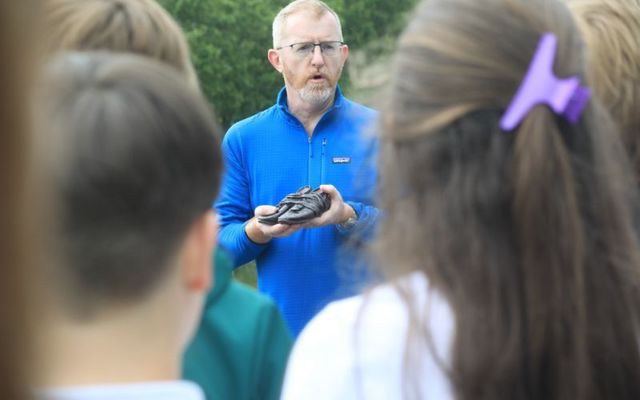Ireland’s Ambassador to Canada Eamonn McKee is following in the footsteps of Famine emigrants from Strokestown, in Roscommon, to Dublin with a group of walkers along the National Famine Way.
The National Famine Way is a 100-mile walking trail that is waymarked with pairs of bronze shoes. Ambassador Eamonn McKee has shared stories with students along the route about the remarkable generosity of Indigenous peoples in Canada who contributed to Irish Famine relief in 1847.
“Through recently discovered archival records, we can now honor indigenous aid from Canada”, said Ambassador McKee.
“At a time when these people were themselves in a desperate situation, they gave selflessly to help alleviate Irish suffering”.
“My students were fascinated to learn about the generosity of Canada’s Indigenous peoples who provided aid during the Great Hunger. They would like thank them,” said Principal Kathryn Keena from Emper National School in Abbeyshrule, County Longford.
“It is such an uplifting story from that dark time”.
The Irish Heritage Trust has released a film entitled Honouring Anishinaabe, Haudenosaunee & Huron-Wendat Irish Famine Aid to mark the occasion. Based on newly discovered archival records, it tells the story of their contributions to help the famine-stricken Irish.
The film features Indigenous descendants from donor communities in Ontario reflecting on the compassion of their ancestors. They had donated over £170 in response to a plea for aid from Indian Agent Thomas G. Anderson on St. Patrick’s Day in 1847.
“The recovery of these letters is shining a light on a page of our history that we have forgotten about”, said Ambassador McKee.
“We know about the Choctaws in the United States. They are memorialized rightly for the contributions that they made to Famine relief. We simply have not heard this story of the Indigenous in Canada”.
“Each one of the letters mentions essentially similar things,” said Professor Mark McGowan from the University of St Michael’s College, in Toronto.
“First, they are greatly distressed by what is happening in Ireland. Secondly, they bring it to council and unanimously agree that a donation should be made.”
He also noted that each of the letters is “signed with a doodem or totem, which is deeply symbolic of a nation reaching out to the distressed of a people that they are in treaty with”.
One of the most remarkable letters was sent by Chiefs Joseph Sawyer and Peter Jones from the Mississaugas of the Credit band on 22 March, 1847. They were about to be removed from their home without knowing where they would relocate. Indeed, their own potato crop had failed. Sawyer and Jones expressed fear that “their suffering for want of food shall be very great” and strove to keep their tribe “from starvation”.
Joseph Sawyer’s descendant, Darin Wybinga, was visibly moved when reading the letter. “We found ourselves just about to be homeless,” he recalled.

Love Irish history? Share your favorite stories with other history buffs in the IrishCentral History Facebook group.
“We had our lands at the Credit River put up for sale, and we had to find a new home. In the midst of this, we are contributing to Famine relief. We are deeply concerned; we are deeply worried. Where are we going to go?”
He added that this “says a lot about the Mississaugas and First Nations peoples everywhere. We had to share in order to survive the harsh environment, to live on the land. I think it came quite naturally to us to share and reach out and help other people. We were very glad to do that because we were no strangers to starvation either.”
“It gives my soul and spirit a great feeling of warmth to know that my ancestors back in that difficult period were kind enough to send relief funds from their community to the Irish”, said Dr. Duke Redbird, an elder from Saugeen First Nation.
“I am very proud that my people were there reaching out across a great ocean to our Irish brethren.”
Dr Mike DeGagné, President and CEO of Indspire, a charity for indigenous university students, found inspiration in these letters offering aid.
“It is important to know that Indigenous people are also on the giving end. There has been some profound generosity in our community throughout our history”, he said.
“We are here to help not only our own communities but the communities around us.”
The largest donation of £25 for Famine relief was offered by the Haudenosaunee Six Nations of the Grand River Territory. Professor Susan Hill, from Six Nations, observed that before 1847 “we had experienced famine ourselves when we were refugees at Fort Niagara” after the American Revolution.
“We know what it is to be hungry”.
The Honouring Indigenous Aid program of events and film releases continues until June 2024. It is hosted by the National Famine Museum, Strokestown Park and Irish Heritage Trust in collaboration with the Embassy of Ireland in Ottawa and the University of St. Michael’s College in the University of Toronto. The Government of Ireland Emigrant Support Programme funds it.
You can watch the Honouring Anishinaabe, Haudenosaunee & Huron-Wendat Irish Famine Aid film here:




Comments